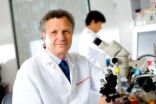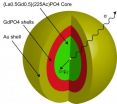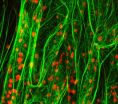(Press-News.org) Scientists at King's College London have demonstrated the ability to deliver a dried live vaccine to the skin without a traditional needle, and shown for the first time that this technique is powerful enough to enable specialised immune cells in the skin to kick-start the immunising properties of the vaccine.
Funded by the Bill & Melinda Gates Foundation and published today in Proceedings of the National Academy of Sciences, researchers say although it is an early study this important technical advance offers a potential solution to the challenges of delivering live vaccines in resource-limited countries globally, without the need for refrigeration. A cheaper alternative to hypodermic needles, it would also remove safety risks from needle contamination and the pain-free administration could lead to more people taking up a vaccination. The researchers add that it could have an impact beyond infectious disease vaccination programmes, for example managing autoimmune and inflammatory conditions such as diabetes.
HIV, malaria and TB represent major global health challenges. Although promising research is underway to develop vaccines for these diseases, considerable stumbling blocks remain for countries where transporting and storing live vaccines in a continuously cold environment (around 2°C to 8°C or below) would not be possible. If a cold chain cannot be maintained for a live vaccine there is a high risk it could become unsafe and lose effectiveness.
The team at King's used a silicone mould developed by US company TheraJect to create a microneedle array – a tiny disc with several micro-needles made of sugar which dissolve when inserted into the skin. The team formulated a dried version of a live modified adenovirus-based candidate HIV vaccine in sugar (sucrose) and used the mould to create the microneedle array. They found that the dried live vaccine remained stable and effective at room temperature.
To test the effectiveness of the microneedle array, they applied it to mice. Using imaging (in collaboration with Professor Frederic Geissmann, King's College London) they observed how the vaccine dissolved in the skin and were able to identify for the first time exactly which specialised immune cells in the skin 'pick up' this type of vaccine and activate the immune system. The researchers found the first evidence that a sub-set of specialised dendritic cells in the skin were responsible for triggering this immune response.
When compared with a traditional needle vaccine method, the immune response generated by the dried microneedle vaccine (kept at room temperature) was equivalent to that induced by the same dose of injected liquid vaccine that had been preserved at -80°C.
Dr Linda Klavinskis from the Peter Gorer Department of Immunobiology at King's College London, said: 'We have shown that it is possible to maintain the effectiveness of a live vaccine by drying it in sugar and applying it to the skin using microneedles – a potentially painless alternative to hypodermic needles. We have also uncovered the role of specific cells in the skin which act as a surveillance system, picking up the vaccine by this delivery system and kick-starting the body's immune processes.
'This work opens up the exciting possibility of being able to deliver live vaccines in a global context, without the need for refrigeration. It could potentially reduce the cost of manufacturing and transportation, improve safety (as there would be no loss in potency), and avoids the need of hypodermic needle injection, reducing the risk of transmitting blood-borne disease from contaminated needles and syringes.
'This new technique represents a huge leap forward in overcoming the challenges of delivering a vaccination programme for diseases such as HIV and malaria. But these findings may also have wider implications for other infectious disease vaccination programmes, for example infant vaccinations, or even other inflammatory and autoimmune conditions such as diabetes.'
###
The published study from King's College London is part of a larger project funded by the Bill & Melinda Gates Foundation linking other groups, including those at Imperial College London and Royal Holloway University of London, who are working on other aspects of HIV vaccination.
CONTACT
Katherine Barnes
International PR Manager
King's College London
Tel: +44 207 848 3076
Email: katherine.barnes@kcl.ac.uk
Notes to editors
*Images available on request*
This work was supported by the Bill & Melinda Gates Foundation.
The team also used equipment made available by the National Institute for Health Research (NIHR) Biomedical Research Centre at Guy's and St Thomas' NHS Foundation Trust and King's College London.
About King's College London
King's College London is one of the top 30 universities in the world (2011/12 QS World University Rankings), and the fourth oldest in England. A research-led university based in the heart of London, King's has nearly 23,500 students (of whom more than 9,000 are graduate students) from nearly 140 countries, and some 6,000 employees. King's is in the second phase of a £1 billion redevelopment programme which is transforming its estate.
King's has an outstanding reputation for providing world-class teaching and cutting-edge research. In the 2008 Research Assessment Exercise for British universities, 23 departments were ranked in the top quartile of British universities; over half of our academic staff work in departments that are in the top 10 per cent in the UK in their field and can thus be classed as world leading. The College is in the top seven UK universities for research earnings and has an overall annual income of nearly £450 million.
King's has a particularly distinguished reputation in the humanities, law, the sciences (including a wide range of health areas such as psychiatry, medicine, nursing and dentistry) and social sciences including international affairs. It has played a major role in many of the advances that have shaped modern life, such as the discovery of the structure of DNA and research that led to the development of radio, television, mobile phones and radar. It is the largest centre for the education of healthcare professionals in Europe; no university has more Medical Research Council Centres.
Injection-free vaccination technique could address global vaccine challenge for HIV, malaria
Scientists demonstrate the ability to deliver a dried live vaccine to the skin without a traditional needle
2013-02-05
ELSE PRESS RELEASES FROM THIS DATE:
Chemical reaction keeps stroke-damaged brain from repairing itself
2013-02-05
LA JOLLA, Calif., February 4, 2013 – Nitric oxide, a gaseous molecule produced in the brain, can damage neurons. When the brain produces too much nitric oxide, it contributes to the severity and progression of stroke and neurodegenerative diseases such as Alzheimer's. Researchers at Sanford-Burnham Medical Research Institute recently discovered that nitric oxide not only damages neurons, it also shuts down the brain's repair mechanisms. Their study was published by the Proceedings of the National Academy of Sciences the week of February 4.
"In this study, we've uncovered ...
Biodiversity exploration in the 3-D era
2013-02-05
Taxonomy – the discipline that defines and names groups of organisms – is a field of science that still employs many of the methods used during the beginnings of the discipline in the 18th century. Despite the increasing use of molecular information to delineate new species, the study of the morphology of specimens remains one of the major tasks of taxonomists. These studies often require first-hand examination of the reference specimens (so-called type material) deposited at museum collections around the globe - a time-consuming and laborious task.
To facilitate this ...
New study finds water tubing-related injuries up 250 percent
2013-02-05
Water tubing, a recreational activity in which participants ride an inner tube which is pulled behind a boat by a tow rope, has grown in popularity in recent years. Unfortunately, the number of injuries related to this activity has also increased.
According to a new study by researchers at the Center for Injury Research and Policy of The Research Institute at Nationwide Children's Hospital, the annual number of water tubing-related injuries increased 250 percent over the 19-year study period, rising from 2,068 injuries in 1991 to 7,216 injuries in 2009. Given that more ...
Finding the way to memory
2013-02-05
Our ability to learn and form new memories is fully dependent on the brain's ability to be plastic – that is to change and adapt according to new experiences and environments. A new study from the Montreal Neurological Institute – The Neuro, McGill University, reveals that DCC, the receptor for a crucial protein in the nervous system known as netrin, plays a key role in regulating the plasticity of nerve cell connections in the brain. The absence of DCC leads to the type of memory loss experienced by Dr. Brenda Milner's famous subject HM. Although HM's memory loss resulted ...
February 2013 story tips from Oak Ridge National Laboratory
2013-02-05
HEALTH – Neutron imaging breast cancer . . .
More precise optical imaging is vital for better diagnosis of breast cancer, which strikes one in eight women annually in the United States alone. Researchers at Oak Ridge National Laboratory and the University of Tennessee are using the neutron imaging beam line at ORNL's High Flux Isotope Reactor to evaluate neutron imaging as a powerful new tool for early detection. The study, led by Dr. Maria Cekanova of UT, working with imaging instrument scientist Hassina Bilheux, is using tissue from dogs treated at the UT College of ...
MU scientists build harness for powerful radiation cancer therapy
2013-02-05
VIDEO:
A new discovery might lead to alpha particle therapy for different types of cancer in the near future.
Click here for more information.
COLUMBIA, Mo. ¬— We've all heard that "it's not wise to use a cannon to kill a mosquito." But what if you could focus the cannon's power to concentrate power into a tiny space? In a new study, University of Missouri researchers have demonstrated the ability to harness powerful radioactive particles and direct them toward small cancer ...
Gene variants found to affect human lifespan
2013-02-05
By broadly comparing the DNA of children to that of elderly people, gene researchers have identified gene variants that influence lifespan, either by raising disease risk or by providing protection from disease.
"This research is the first genome-wide, population-based study of copy number variations in children associated with human longevity," said study leader Hakon Hakonarson, M.D., Ph.D., director of the Center for Applied Genomics at The Children's Hospital of Philadelphia.
The study appeared Jan. 30 in the open-access journal PLOS ONE.
Copy number variations ...
1990s drop in NYC crime not due to CompStat, misdemeanor arrests, study finds
2013-02-05
New York City experienced a historic decline in crime rates during the 1990s, but it was not due to the implementation of CompStat or enhanced enforcement of misdemeanor offenses, according to an analysis by New York University sociologist David Greenberg. The study, which appears in the journal Justice Quarterly, did not find a link between arrests on misdemeanor charges and drops in felonies, such as homicides, robberies, and assaults. In addition, the analysis revealed no significant drop in violent or property crime attributable to the NYPD's introduction of CompStat ...
How plants sense gravity -- a new look at the roles of genetics and the cytoskeleton
2013-02-05
Gravity affects the ecology and evolution of every living organism. In plants, the general response to gravity is well known: their roots respond positively, growing down, into the soil, and their stems respond negatively, growing upward, to reach the sunlight. But how do plants sense gravity and how do they direct or signal their cells to grow in response to it? Although botanists understand a great deal about how this works, a recent article in the recent issue of the American Journal of Botany reviews what we know so far, from mechanical to genetic approaches; it reveals ...
Some cancer mutations slow tumor growth
2013-02-05
CAMBRIDGE, MA -- A typical cancer cell has thousands of mutations scattered throughout its genome and hundreds of mutated genes. However, only a handful of those genes, known as drivers, are responsible for cancerous traits such as uncontrolled growth. Cancer biologists have largely ignored the other mutations, believing they had little or no impact on cancer progression.
But a new study from MIT, Harvard University, the Broad Institute and Brigham and Women's Hospital reveals, for the first time, that these so-called passenger mutations are not just along for the ride. ...
LAST 30 PRESS RELEASES:
Groundbreaking discovery turns household plastic recycling into anti-cancer medication
Blocking a key inflammatory pathway improves liver structure and vascular function in cirrhosis, study finds
Continuous spread: Raccoon roundworm detected in nine European countries
HKUST Engineering researchers developed a novel photodetector to enhance the performance of on-chip light monitoring
Strategic river sensors could have forewarned of Texas Camp flood disaster
Drone sampling of whale breath reveals first evidence of potentially deadly virus in Arctic
Roman soldiers defending Hadrian’s Wall infected by parasites, study finds
Pinochet’s prisoners were tormented with music but still found solace in it, a new book reveals
Fertility remains high in rural Tanzania despite access to family planning
AI-assisted device can improve autism care access
Kinetic careers
Uncovering how parasitic plants avoid attacking themselves to improve crop resistance
Nanoparticle vaccine strategy could protect against Ebola and other deadly filoviruses
Study finds brain care score can predict risk of stroke across racial groups
Key lung immune cells can intensify allergic reactions
Do hormones explain why women experience more gut pain?
New materials conduct ions in solids as easily as in liquids
Breakthrough of the Year: Renewable energy begins to eclipse fossil fuel-based sources
LLM use is reshaping scientific enterprise by increasing output, reducing quality and more
Introducing LightGen, a chip for ultra-fast, ultra-efficient generative AI
Astronomers see fireworks from violent collisions around nearby star
ACC/AHA issue new guideline on managing congenital heart disease in adults
Cosmic crash caught on camera
Is talented youth nurtured the wrong way? New study shows: top performers develop differently than assumed
Ants: An untapped resource in the development of antibiotics?
Archaeologists use AI to create prehistoric video game
Mitochondria migrate toward the cell membrane in response to high glucose levels
Tiny viral switch offers hope against drug-resistant bacteria
Most parents aware of early peanut introduction guidelines, but confused about details
HPV vaccine can protect against severe lesions of the vulva and vagina
[Press-News.org] Injection-free vaccination technique could address global vaccine challenge for HIV, malariaScientists demonstrate the ability to deliver a dried live vaccine to the skin without a traditional needle



